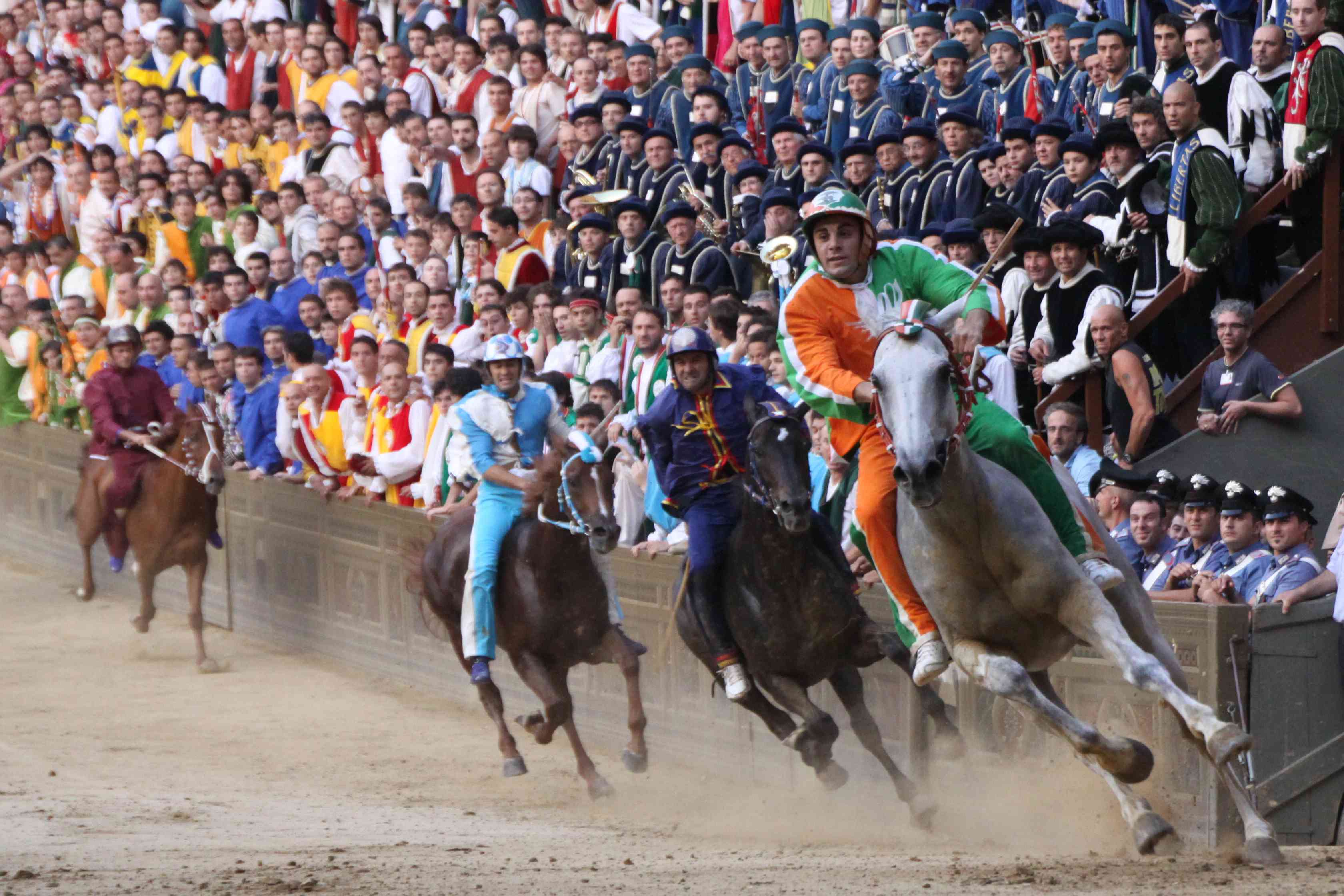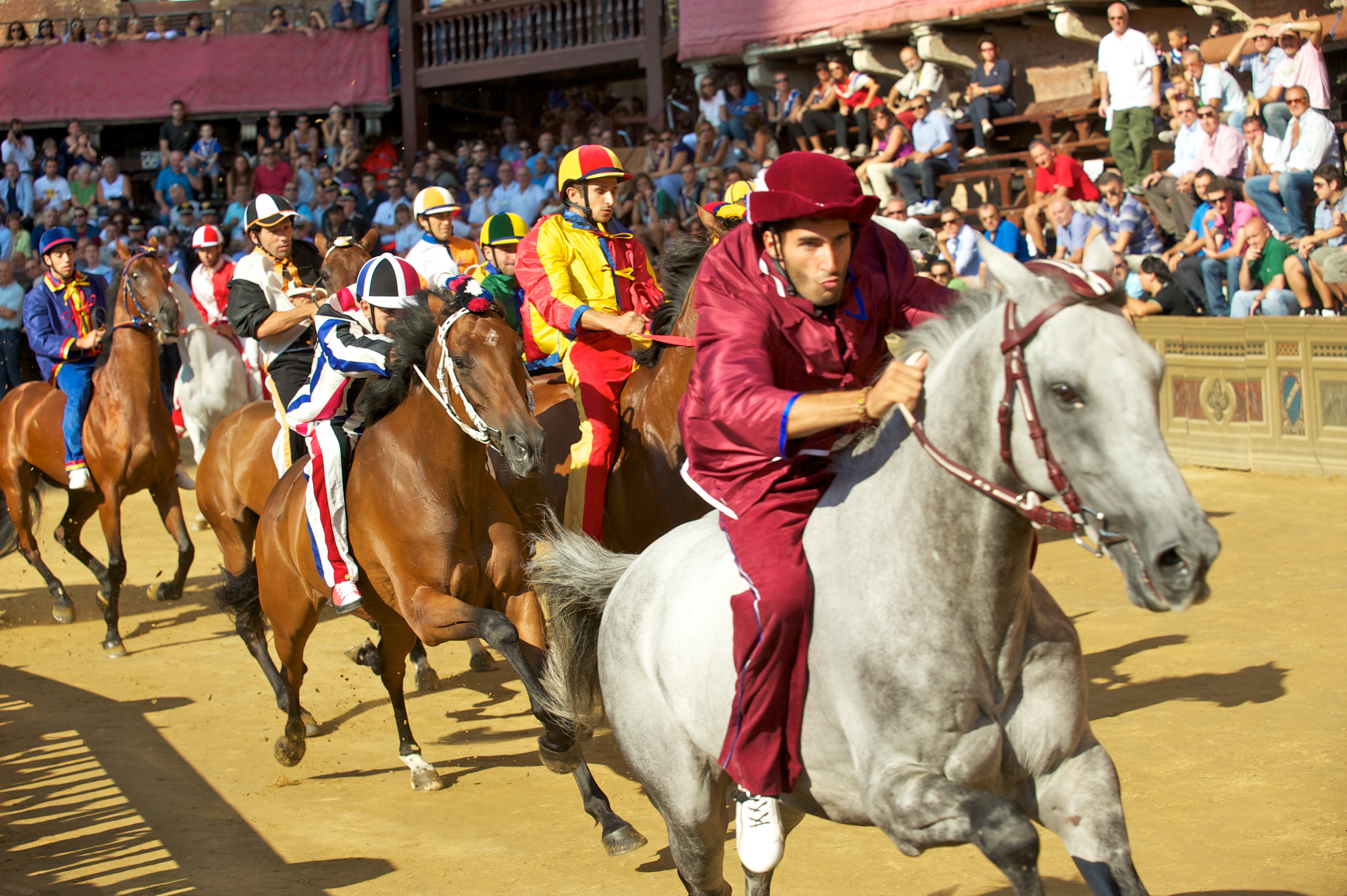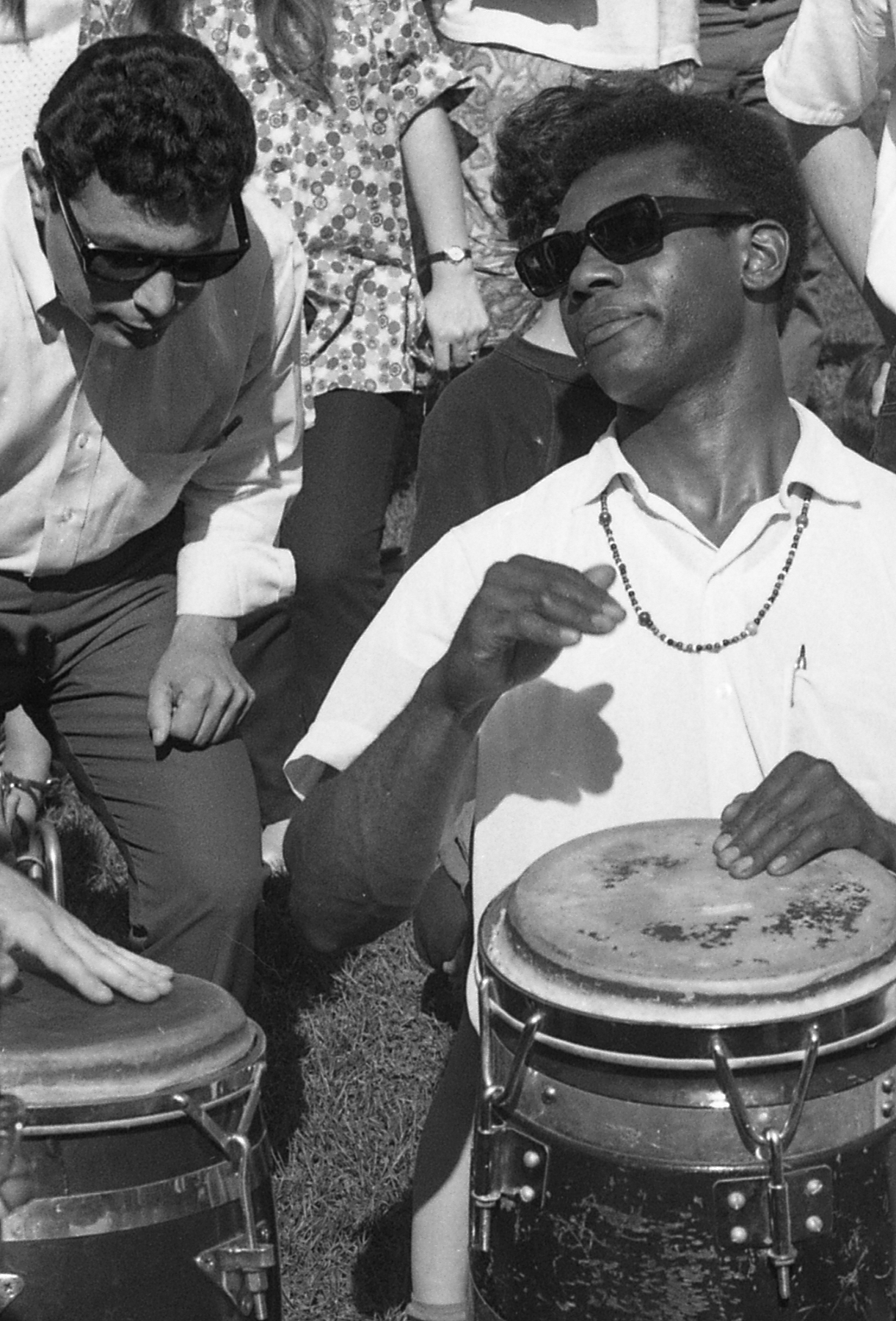|
Corteo Storico
The Corteo Storico is a historical costume parade in Siena, Tuscany, Italy. It takes place before the famous horse race known as the Palio on the 2nd of July and on August 16, each year. Description The parade has always occurred before the Palio since the race's inception. It is a formally choreographed triumphal march that commemorates the ancient institutions, customs and greatness of the Republic of Siena. Special attention is given to the Contrade whose participants form the main part of the parade. The parade takes place in the Piazza del Campo with 14 groups and a total of almost seven hundred participants. In the early afternoon, on the day of the Palio, members of the town gather in the courtyard of the Palace of Justice and under the command of the field marshal, line-up in Piazza del Duomo next to the cathedral. They parade between the crowd on both sides of the streets called: Via del Capitano, Piazza Postierla, Via San Pietro, Via del Casato di Sopra and Via del Ca ... [...More Info...] [...Related Items...] OR: [Wikipedia] [Google] [Baidu] |
Palio - Carrocio
Palio is the name given in Italy to an annual athletic contest, very often of a historical character, pitting the neighbourhoods of a town or the hamlets of a ''comune'' against each other. Typically, they are fought in costume and commemorate some event or tradition of the Middle Ages and thus often involve horse racing, archery, jousting, crossbow shooting, and similar medieval sports. Once purely a matter of local rivalries, many have now become events that are staged with an eye to visitors and foreign tourists. The Palio di Siena is the only one that has been run without interruption since it started in the 1630s and is definitely the most famous all over the world. Its historical origins are documented since 1239 even though the version seen today was the final evolution of races held from the second half of the 16th century. In 1935, Italian Prime Minister Benito Mussolini sent out an official declaration that only the one of Siena could bring the designation of Palio. Al ... [...More Info...] [...Related Items...] OR: [Wikipedia] [Google] [Baidu] |
Helmet
A helmet is a form of protective gear worn to protect the head. More specifically, a helmet complements the skull in protecting the human brain. Ceremonial or symbolic helmets (e.g., a policeman's helmet in the United Kingdom) without protective function are sometimes worn. Soldiers wear combat helmets, often made from Kevlar or other lightweight synthetic fibers. The word ''helmet'' is derived from ''helm'', an Old English word for a protective head covering. Helmets are used for recreational activities and sports (e.g., jockeys in horse racing, American football, ice hockey, cricket, baseball, camogie, hurling and rock climbing); dangerous work activities such as construction, mining, riot police, military aviation, and in transportation (e.g. motorcycle helmets and bicycle helmets). Since the 1990s, most helmets are made from resin or plastic, which may be reinforced with fibers such as aramids. Designs Some British gamekeepers during the 18th and 19th centuries wore he ... [...More Info...] [...Related Items...] OR: [Wikipedia] [Google] [Baidu] |
Italian Traditions
Traditions of Italy are sets of traditions, beliefs, values, and customs that belongs within the culture of Italian people. These traditions have influenced life in Italy for centuries, and are still practiced in modern times. Italian traditions are directly connected to Italy's ancestors, which says even more about Italian history. Overview Christmas Christmas in Italy ( it, Natale) begins on 8 December, with the feast of the Immaculate Conception, the day on which traditionally the Christmas tree is mounted and ends on 6 January, of the following year with the Epiphany (in Italian: ''Epifania''). The term "Natale" derives from the Latin ''natalis'', which literally means "birth", and the Greetings formulas in Italian are ( Merry Christmas) and ( Happy Christmas). The tradition of the nativity scene comes from Italy. What is considered the first nativity scene in history (a living nativity scene) was set up by St. Francis Of Assisi in Greccio in 1223. However, nativi ... [...More Info...] [...Related Items...] OR: [Wikipedia] [Google] [Baidu] |
Laurel Wreath
A laurel wreath is a round wreath made of connected branches and leaves of the bay laurel (), an aromatic broadleaf evergreen, or later from spineless butcher's broom (''Ruscus hypoglossum'') or cherry laurel (''Prunus laurocerasus''). It is a symbol of triumph and is worn as a chaplet around the head, or as a garland around the neck. The symbol of the laurel wreath traces back to Ancient Greece. In Greek mythology, the god Apollo, who is patron of lyrical poetry, musical performance and skill-based athletics, is conventionally depicted wearing a laurel wreath on his head in all three roles. Wreaths were awarded to victors in athletic competitions, including the ancient Olympics; for victors in athletics they were made of wild olive tree known as ''" kotinos"'' (), (sc. at Olympia) – and the same for winners of musical and poetic competitions. In Rome they were symbols of martial victory, crowning a successful commander during his triumph. Whereas ancient laurel wreaths are mos ... [...More Info...] [...Related Items...] OR: [Wikipedia] [Google] [Baidu] |
Procession
A procession is an organized body of people walking in a formal or ceremonial manner. History Processions have in all peoples and at all times been a natural form of public celebration, as forming an orderly and impressive ceremony. Religious and triumphal processions are abundantly illustrated by ancient monuments, e.g. the religious processions of Egypt, those illustrated by the rock-carvings of Boghaz-Keui, the many representations of processions in Greek art, culminating in the great Panathenaic procession of the Parthenon Frieze, and Roman triumphal reliefs, such as those of the arch of Titus. Greco-Roman practice Processions played a prominent part in the great festivals of Greece, where they were always religious in character. The games were either opened or accompanied by more or less elaborate processions and sacrifices, while processions from the earliest times formed part of the worship of the old nature gods, as those connected with the cult of Dionysus and the Ph ... [...More Info...] [...Related Items...] OR: [Wikipedia] [Google] [Baidu] |
Archery
Archery is the sport, practice, or skill of using a bow to shoot arrows.Paterson ''Encyclopaedia of Archery'' p. 17 The word comes from the Latin ''arcus'', meaning bow. Historically, archery has been used for hunting and combat. In modern times, it is mainly a competitive sport and recreational activity. A person who practices archery is typically called an archer, bowman, or toxophilite. History Origins and ancient archery The oldest known evidence of the bow and arrow comes from South African sites such as Sibudu Cave, where the remains of bone and stone arrowheads have been found dating approximately 72,000 to 60,000 years ago.Backwell L, d'Errico F, Wadley L.(2008). Middle Stone Age bone tools from the Howiesons Poort layers, Sibudu Cave, South Africa. Journal of Archaeological Science, 35:1566–1580. Backwell L, Bradfield J, Carlson KJ, Jashashvili T, Wadley L, d'Errico F.(2018). The antiquity of bow-and-arrow technology: evidence from Middle Stone Age layers ... [...More Info...] [...Related Items...] OR: [Wikipedia] [Google] [Baidu] |
Bishops
A bishop is an ordained clergy member who is entrusted with a position of authority and oversight in a religious institution. In Christianity, bishops are normally responsible for the governance of dioceses. The role or office of bishop is called episcopacy. Organizationally, several Christian denominations utilize ecclesiastical structures that call for the position of bishops, while other denominations have dispensed with this office, seeing it as a symbol of power. Bishops have also exercised political authority. Traditionally, bishops claim apostolic succession, a direct historical lineage dating back to the original Twelve Apostles or Saint Paul. The bishops are by doctrine understood as those who possess the full priesthood given by Jesus Christ, and therefore may ordain other clergy, including other bishops. A person ordained as a deacon, priest (i.e. presbyter), and then bishop is understood to hold the fullness of the ministerial priesthood, given responsibility by ... [...More Info...] [...Related Items...] OR: [Wikipedia] [Google] [Baidu] |
Guilds
A guild ( ) is an association of artisans and merchants who oversee the practice of their craft/trade in a particular area. The earliest types of guild formed as organizations of tradesmen belonging to a professional association. They sometimes depended on grants of letters patent from a monarch or other ruler to enforce the flow of trade to their self-employed members, and to retain ownership of tools and the supply of materials, but were mostly regulated by the city government. A lasting legacy of traditional guilds are the guildhalls constructed and used as guild meeting-places. Guild members found guilty of cheating the public would be fined or banned from the guild. Typically the key "privilege" was that only guild members were allowed to sell their goods or practice their skill within the city. There might be controls on minimum or maximum prices, hours of trading, numbers of apprentices, and many other things. These rules reduced free competition, but sometimes maintained ... [...More Info...] [...Related Items...] OR: [Wikipedia] [Google] [Baidu] |
Rector (academia)
A rector (Latin for 'ruler') is a senior official in an educational institution, and can refer to an official in either a university or a secondary school. Outside the English-speaking world the rector is often the most senior official in a university, whilst in the United States the most senior official is often referred to as president and in the United Kingdom and Commonwealth of Nations the most senior official is the chancellor, whose office is primarily ceremonial and titular. The term and office of a rector can be referred to as a rectorate. The title is used widely in universities in EuropeEuropean nations where the word ''rector'' or a cognate thereof (''rektor'', ''recteur'', etc.) is used in referring to university administrators include Albania, Austria, the Benelux, Bosnia and Herzegovina, Bulgaria, Croatia, Cyprus, Czech Republic, Denmark, Estonia, Finland, Germany, Greece, Hungary, Iceland, Italy, Latvia, Malta, Moldova, North Macedonia, Poland, Portugal, Romani ... [...More Info...] [...Related Items...] OR: [Wikipedia] [Google] [Baidu] |
Drummers
A drummer is a percussionist who creates music using drums. Most contemporary western bands that play rock, pop, jazz, or R&B music include a drummer for purposes including timekeeping and embellishing the musical timbre. The drummer's equipment includes a drum kit (or "drum set" or "trap set"), which includes various drums, cymbals and an assortment of accessory hardware such as pedals, standing support mechanisms, and drum sticks. Particularly in the traditional music of many countries, drummers use individual drums of various sizes and designs rather than drum kits. Some use only their hands to strike the drums. In larger ensembles, the drummer may be part of a rhythm section with other percussionists playing. These musicians provide the timing and rhythmic foundation which allow the players of melodic instruments, including voices, to coordinate their musical performance. Some famous drummers include: Max Roach, Ringo Starr (The Beatles), John Bonham (Led Zeppe ... [...More Info...] [...Related Items...] OR: [Wikipedia] [Google] [Baidu] |
Centurion
A centurion (; la, centurio , . la, centuriones, label=none; grc-gre, κεντυρίων, kentyríōn, or ) was a position in the Roman army during classical antiquity, nominally the commander of a century (), a military unit of around 80 legionaries. In a Roman legion, centuries were grouped into cohorts and commanded by their senior-most centurion. The prestigious first cohort was led by the ''primus pilus'', the most senior centurion in the legion and its fourth-in-command who was next in line for promotion to Praefectus Castrorum, and the primi ordines who were the centurions of the first cohort. A centurion's symbol of office was the vine staff, with which they disciplined even Roman citizens, who were otherwise legally protected from corporal punishment by the Porcian Laws. Centurions also served in the Roman navy. After the 107 BC Marian reforms of Gaius Marius, centurions were professional officers. In Late Antiquity and the Middle Ages, the Byzantine army's cen ... [...More Info...] [...Related Items...] OR: [Wikipedia] [Google] [Baidu] |









